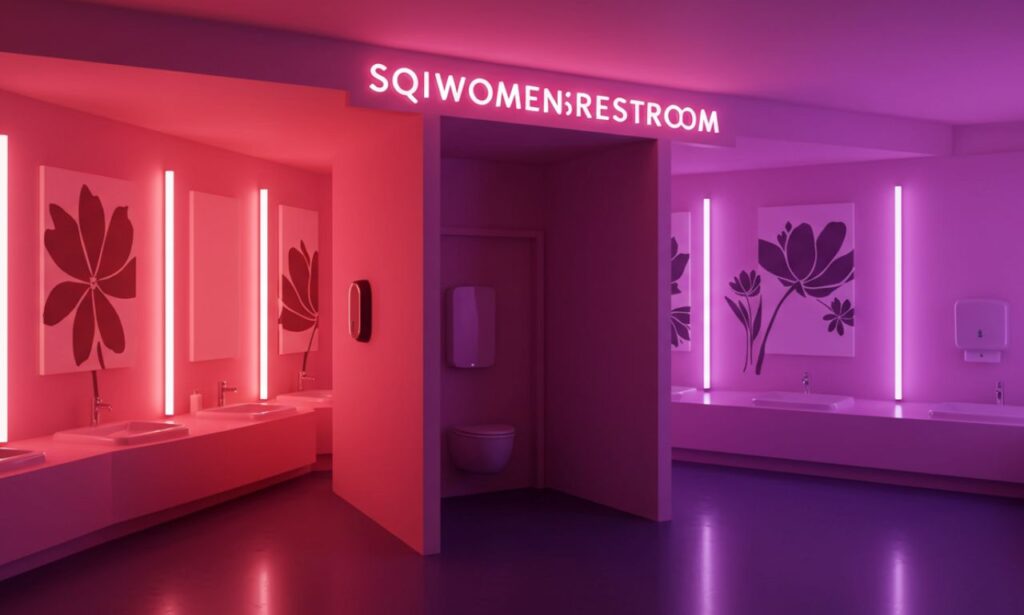The topic sqrwomensrestroom may not yet be familiar to all, but that is changing rapidly. In modern public infrastructure and building design, sqrwomensrestroom is emerging as a concept intended to elevate how women’s restrooms function—beyond mere utility to dignified, safe, accessible, and hygienic experiences. This article dives into what sqrwomensrestroom means, why it matters, design principles, challenges, and the future of women’s restroom spaces.
What Is SqrWomensRestroom?
The term sqrwomensrestroom refers to a reimagined women’s restroom model that integrates advanced privacy, safety, hygiene, and accessibility features. At its core, a sqrwomensrestroom is not just about toilets and sinks—it’s about designing a restroom environment tailored to women’s specific needs, with modern infrastructure, inclusive design, and user dignity built into every detai
While traditional women’s restrooms often follow basic standards, sqrwomensrestroom represents a leap forward—embracing touchless technology, improved layouts, sensory comfort, and universal access. Some of the reported features include sensor-controlled faucets, automatic flushes, spacious and enclosed stalls, ventilation optimized for comfort, and materials aimed at cleanliness and durability.
Why SqrWomensRestroom Matters Today
Why invest in a concept like sqrwomensrestroom? Several societal trends and user expectations drive this shift:
-
Dignity and comfort: Women in public restrooms often face issues of inadequate privacy, cramped settings, or poor maintenance. The sqrwomensrestroom model seeks to restore dignity to restroom users by design.
-
Hygiene and health: Especially after global health awareness rose, minimizing touchpoints and improving ventilation are viewed as essential. sqrwomensrestroom expressly incorporates these elements.
-
Accessibility and inclusivity: Women’s restrooms must serve a diverse population—pregnant women, caregivers, women with disabilities. sqrwomensrestroom aims for universal design.
-
Public expectation: In modern buildings, users expect more—not just functional restrooms but ones that are well-maintained, safe, and comfortable. The sqrwomensrestroom concept aligns with elevated user expectations.
Thus, sqrwomensrestroom responds to real demands: improving women’s experiences, reducing health risks, and aligning infrastructure with inclusive values.
Key Design Principles for SqrWomensRestroom
To make sqrwomensrestroom a reality, designs typically follow several guiding principles. Let’s break them down:
Privacy & Enclosed Stalls
A hallmark of sqrwomensrestroom is enclosed, full-height stalls or well-sealed partitions to limit visibility and sound leakage. This design supports a sense of security and personal space.
Touchless Fixtures & Reduced Contact
Sensor faucets, auto flush toilets, motion-activated soap dispensers, and automatic doors reduce surface contact, helping hygiene and reducing microbial transmission.
Ventilation, Airflow & Odor Control
Proper ventilation is crucial to ensure fresh air, reduce odor, and manage humidity. sqrwomensrestroom designs emphasize effective HVAC flow, exhaust, and fresh air intake.
Layout & Traffic Flow
A good sqrwomensrestroom design accounts for ingress and egress patterns to avoid congestion. Thoughtful layout ensures that sinks, stalls, entrance, exit, and hand-drying zones do not clash.
Accessibility & Universal Design
Features include wide stalls for wheelchairs, grab bars, lowered or adjustable sinks, baby changing tables, and clear signage (including braille or tactile). sqrwomensrestroom aspires to serve all women, regardless of mobilit
Choice & Cultural Sensitivity
Some users prefer single-occupancy private restrooms, or family restrooms where caregivers assist children. The sqrwomensrestroom model often incorporates flexible options to respect cultural norms.
Durable, Cleanable Material
Materials that resist stains, moisture, vandalism, and that are easy to maintain (antimicrobial surfaces, sealed seams) are preferred in sqrwomensrestroom schematics.
Ambient & Lighting Design
Natural light or well-balanced artificial light improves the feeling of cleanliness and reduces anxiety in a confined space. Color schemes, décor, and finishes contribute to a calming ambiance.
Implementation in Existing Facilities
Transitioning to a sqrwomensrestroom model doesn’t always mean demolishing everything. Many retrofits and upgrades are possible:
-
Audit & user feedback: Start by assessing existing restrooms for shortcomings in privacy, hygiene, and accessibility. Solicit feedback from women using them.
-
Phased upgrades: Prioritize critical fixes—improving ventilation, adding touchless fixtures, reinforcing stall privacy—before tackling aesthetics.
-
Modular redesigns: Using modular partitions, retrofit privacy enclosures or reconfigure stall layouts.
-
Staff training & maintenance: Sustainable success means training cleaning and maintenance teams to care for sensor systems, sensitive equipment, and surfaces.
-
Budgeting and cost control: Use cost-efficient materials that approximate the look and function of more expensive finishes. Seek grants or institutional funding for inclusive upgrades.
By treating sqrwomensrestroom as an evolving standard, facility managers can gradually transform restrooms without full reconstruction.
Benefits of SqrWomensRestroom
Adopting sqrwomensrestroom brings a range of advantages:
-
Improved user satisfaction: Women feel safer, more respected, and less anxious.
-
Better hygiene and health: Lower touchpoints and improved airflow reduce pathogen spread.
-
Inclusive access: Women with disabilities, caregivers, elderly users benefit from larger, better-equipped restrooms.
-
Reduced maintenance issues: Durable materials and sensor systems can reduce wear and tear.
-
Modern brand image: Buildings or institutions that invest in thoughtful women’s restroom design signal respect for users—making a positive reputation.
These benefits justify the investment from human, health, and reputational perspectives.
Challenges and Considerations
However, sqrwomensrestroom is not without hurdles. Awareness of these helps in planning realistically.
Cost & Resource Constraints
High-end sensor systems, premium materials, and redesigns require capital. Smaller facilities may struggle. Creative budgeting, phased work, and scaled implementations can help mitigate this.
Technical Reliability
Sensors, automatic doors, flush systems, and other tech must be robust, resistant to vandalism, and suitable for heavyuse. Frequent failures would degrade user trust.
Cultural, Regulatory, and Normative Resistance
In some regions, expectations about gender-segregated restrooms are traditional. Change may face resistance from authorities or communities. Education and pilot projects are important.
Maintenance Oversight
Even the best features decay without maintenance. Regular inspections, cleaning, and repair are essential to preserve the quality promised by sqrwomensrestroom.
Equity vs Exclusivity
While many women benefit, decisions must avoid exclusion—ensuring cost increases or design changes don’t reduce access. Striking balance is key.
Future Trends & Innovations
Looking ahead, the sqrwomensrestroom concept may adopt more advanced technologies and sustainable strategies:
-
IoT & real-time monitoring: Sensors could report stall occupancy, supply levels, air quality, or maintenance alerts.
-
Predictive maintenance: Systems detect failing fixtures before breakdown.
-
Green systems: Water recycling, low-flow fixtures, solar ventilation, energy recovery systems.
-
Adaptive design: Modular stalls that reconfigure to user demand during peak/off-peak hours.
-
Smart accessibility: Personalized height-adjustable counters, voice-activated controls, or multi-lingual assistance.
-
Augmented reality or guidance apps: Users find nearest restroom, check status, or report problems from a mobile interface.
These innovations promise that sqrwomensrestroom remains forward-looking, sustainable, and user-centric.
Real-World Use Cases & Pilot Projects
Some buildings and institutions have begun incorporating elements of the sqrwomensrestroom model:
-
Public transit hubs installing touchless women’s restroom modules with enclosed cubicles.
-
Shopping centers adopting enhanced women’s restroom sections with improved ventilation, privacy, and child care features.
-
Educational institutions revamping women’s restrooms to include accessible stalls, family restrooms, and sensor-driven fixtures.
-
Private offices upgrading restrooms to sensor faucets, auto flush, and better layout to reduce congestion during peak hours.
Though full sqrwomensrestroom adoption is nascent, these pilots suggest growing interest and feasibility.
How to Advocate for SqrWomensRestroom
If you want to see sqrwomensrestroom standards adopted in your area, here are steps to take:
-
Raise awareness: Present comparison of existing restroom deficiencies vs benefits of improved design.
-
Gather user voices: Collect feedback and demands from women, caregivers, and accessibility advocates.
-
Work with facility planners: Engage architects, engineers, and facility managers to explore retrofits.
-
Show pilot success: Use small-scale demonstration restrooms to show value in user satisfaction or reduced maintenance.
-
Policy and standard push: Advocate for building codes or guidelines that mandate higher standards for women’s restrooms in public buildings.
By championing sqrwomensrestroom, individuals and groups can push restroom design forward for better equity and user experiences.
Summary
SqrWomensRestroom is more than a term—it’s a design philosophy redefining women’s public restrooms. By elevating privacy, hygiene, accessibility, and user dignity, it addresses longstanding shortcomings in restroom design. Realizing it requires thoughtful planning, maintenance, and sensitivity to cultural context—but its benefits for women, caregivers, and inclusive communities are substantial. As standards rise, sqrwomensrestroom may become the benchmark, not a luxury, marking progress in how public spaces serve all users.
Frequently Asked Questions
What makes a restroom “sqrwomensrestroom” rather than a normal women’s restroom?
A sqrwomensrestroom incorporates enhanced elements—full privacy stalls, touchless fixtures, optimal ventilation, universal access, sensitive layout and durable materials. It goes beyond baseline standards to focus on dignity, safety, and hygiene.
Can existing restrooms be converted into sqrwomensrestroom style?
Yes—through audits, phased upgrades, modular partitions, retrofit of sensor fixtures, and layout reconfiguration. It may not reach full ideal immediately but can evolve.
Is the cost of sqrwomensrestroom prohibitive for small buildings?
While certain features (tech, premium materials) carry cost, many gains come from smart layout, privacy fixes, and better ventilation. Small buildings can adopt selective improvements to raise quality without full-scale overhaul.
Does sqrwomensrestroom benefit women with disabilities or caregivers?
Absolutely. Universal design, wider stalls, lower sinks, baby changing areas, accessible routes—all aim to make the restroom usable for women of varied needs.
Could technical systems (sensor faucets, automatic doors) fail often and cause inconvenience?
That is a risk. Good design demands robust, durable systems, regular maintenance, and fallback manual controls where needed to minimize disruption.
Will the concept of sqrwomensrestroom be widely accepted in traditional societies?
Acceptance depends on education, demonstration of practical benefits, empathy, and sometimes gradual adoption. Pilot projects and stakeholder dialogue can help bridge resistance.







